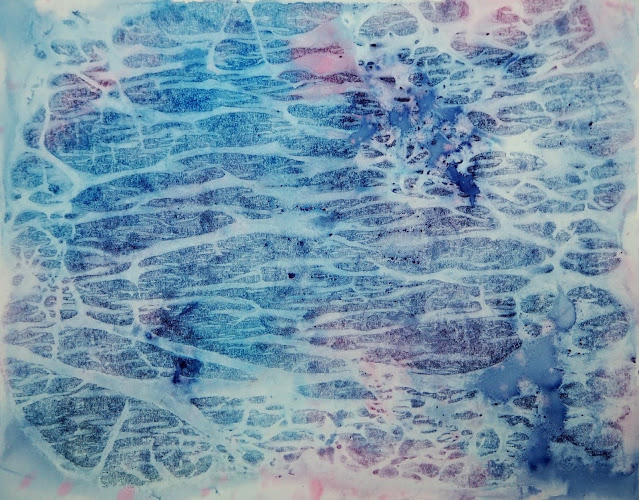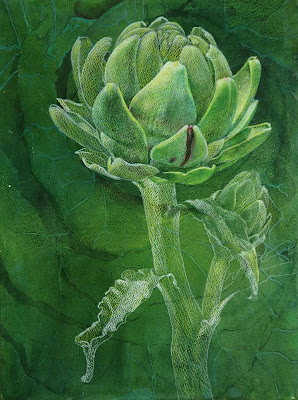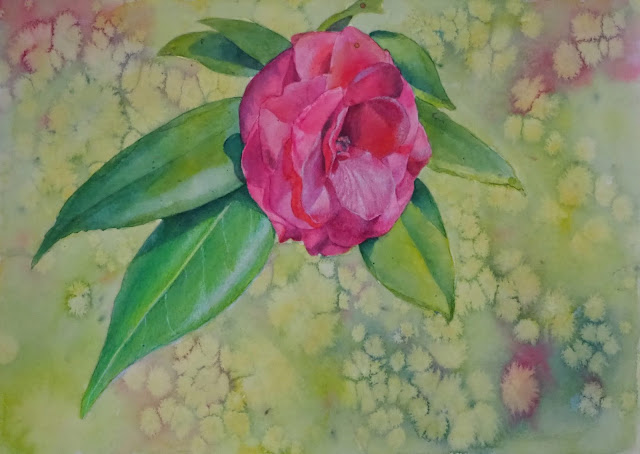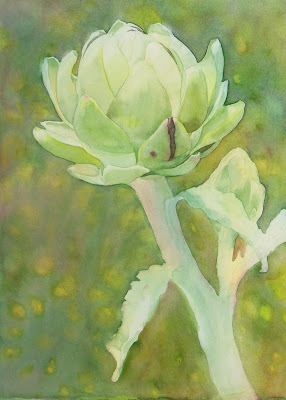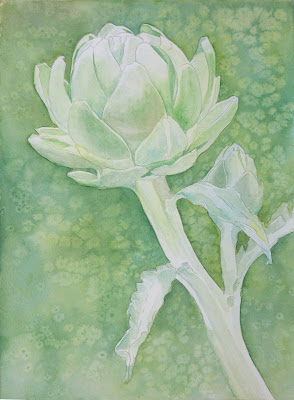I demonstrated using less water for more control to add some darks and details to the head of the artichoke. I generally work light to dark, wet to dry. The first passes tend to be wet-in-wet, getting more dry and working in smaller areas with each pass. I added some darks and some of the lined textures as well as red for the damaged spots.
I did about 3 layers/passes in the red (cool red with a little green). The first pass was a medium light red over the entire area. The next pass was slightly darker red and I worked in less of the area, just the shadows. The third pass was darker and an even smaller area putting dark red into the darkest areas of the shadows. If necessary I could lift out more highlights at some point in the red area.
The leaf that I started in class, I demonstrated the first pass. I wet the areas where I wanted the color to flow. I added a little more color in the darker areas and a little less in the lighter areas. The next pass will be to add the next darkest layer of shadow. I will work towards the darkest shadows getting darker and more dry as I go.
I demonstrated lifting with a soft brush and then the Eradicator Brush (which is new to me and worked really well). I demonstrated and talked about scrubbing which I usually only do at the end of a painting to correct areas. I do it at the end since it changes the surface of the paper which makes it difficult to continue painting in that area. I forgot to mention that I sometimes use scrubbing at the end not to fix issues, but to add texture in some paintings.
I demonstrated glazes. Glazes are light mixtures of color used to change the temperature of an area or to slightly alter the color of an area. I demonstrated some red, yellow and blue glazes on some of the bracts.
I demonstrated adding color to the background. I did this in a small area for demonstration purposes. I wet the background area, making it very wet so the paint will move, and dropped in color (the color choice is yours if you decide to add a background). I dropped in red (mixed from both my warm and cool reds) and then a green (mixed with my green blue and my warm yellow). I did not mess with the color much, otherwise it would mix and make brown. I will most likely do a glaze or two over this background once I finish the background.
I demonstrated dampening the stem in a few areas as well as a few bracts/petals, while the background was still wet, allowing background color to move into those areas. This "attaches" the subject to the background and makes areas of soft edges. I can also make soft edges by running a damp brush over an edge.
Be patient with yourselves, remember you can't do everything at once. Work general to specific, light to dark, wet to dry. Save your whites and if you lose some lift them back out.
For this one start with your cool red only. Use it and the amounts of water to pigment to do a value study on the entire piece. This will help you get a better grasp on water amounts. This is key, understanding what the watercolor does with the varying amount of water on the paper, in your brush, and in the pigment. Have a towel or cloth to help you monitor the amount of water on your brush.
And practice, practice, practice!!!


